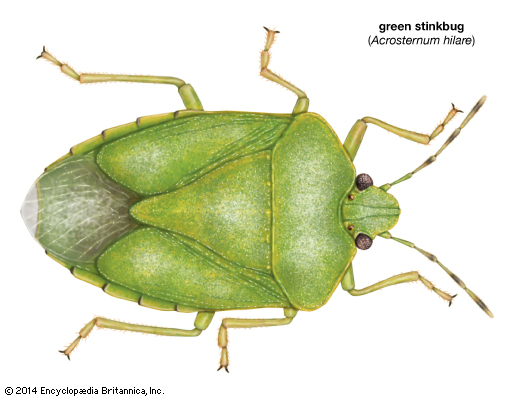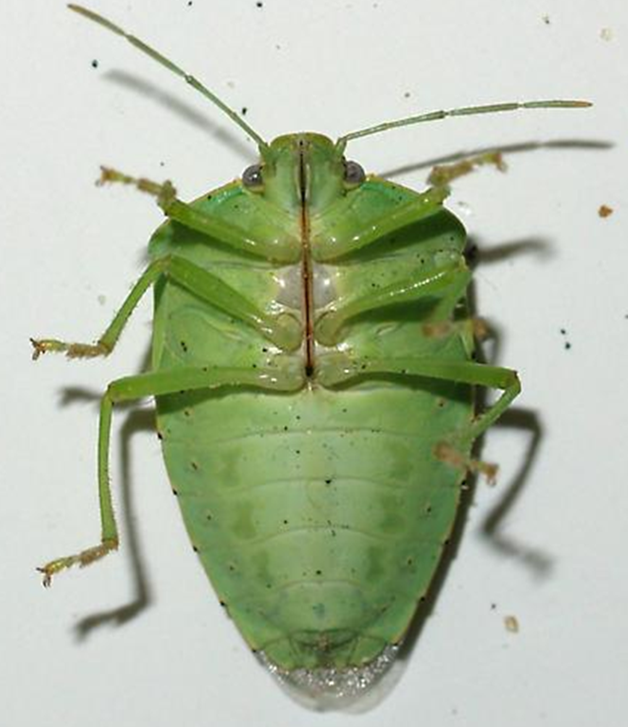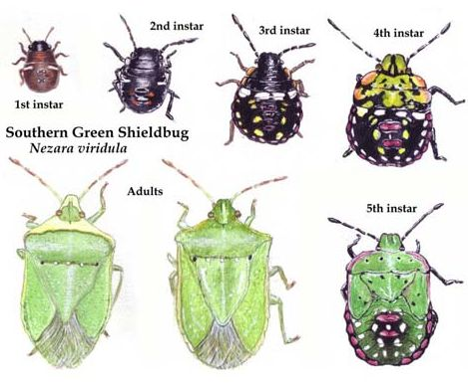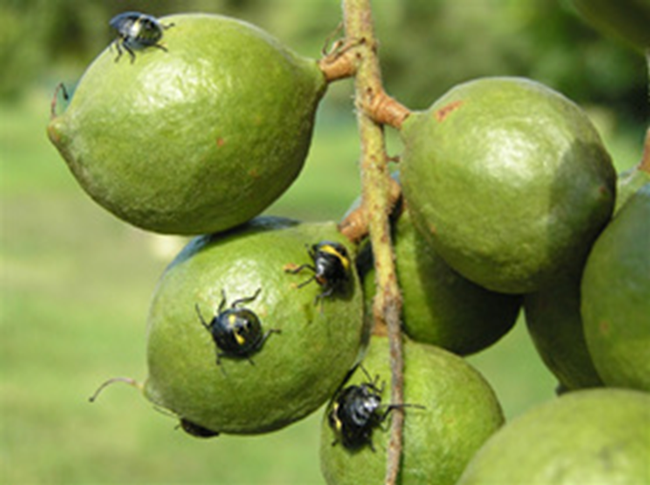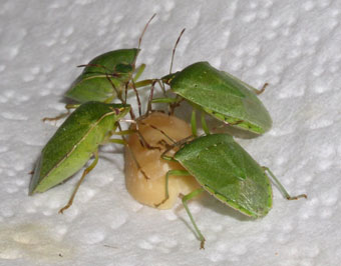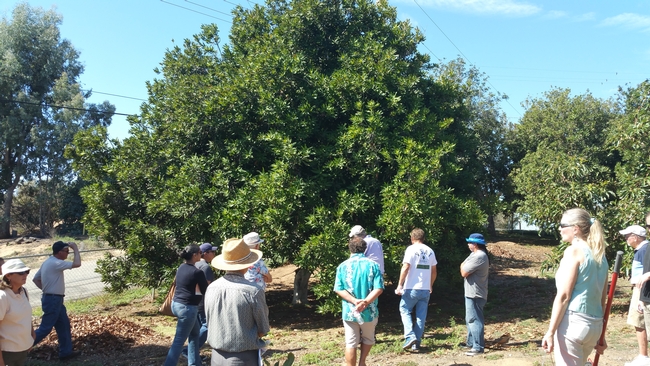
Posts Tagged: nuts
Green Stink Bugs in Macadamias
The green stink bug is the dominant species found in fruit and nut trees; the others are found primarily in vegetables. Stink bug infestations originate when adults fly in from weedy areas. Damage is often limited to the edges of fields near these areas, but in years with a lot of spring rain and late weed growth, stink bugs may be numerous and damage more widespread. The southern green stink bug has piercing-sucking mouthparts. The mouth consists of a long beak-like structure called the rostrum. Salivary fluid is pumped down the salivary duct and liquefied food is pumped up the food canal.
Life Cycle
The southern green stink bug can complete its life cycle in 65 to 70 days. Females can lay eggs 3-4 weeks after becoming adults. A female southern green stink bug could lay as many as 260 eggs over her life span. The eggs are drum-shaped with circular "lids" are laid ire deposited on the undersides of leaves. The nymphs, nearly round & often brightly colored, remain close together at first but scatter as they grow. They pass through four or five molts, gradually developing wings & adult coloration.
Damage
Overwinters as an adult, & hides in the bark of trees, leaf litter, or other locations to obtain protection from the weather. As spring temperatures begin to warm, the southern green stink bug moves out of the winter cover to feed. Is normally determined after nuts are harvested & processed, which may be many months after damage occurred in the field. Damage occurs to the nut when the stink bug places its stylet-like mouthparts on the nut husk & secretes saliva containing a suite of digestive enzymes that softens the husk, allowing it to insert its mouthparts through the husk and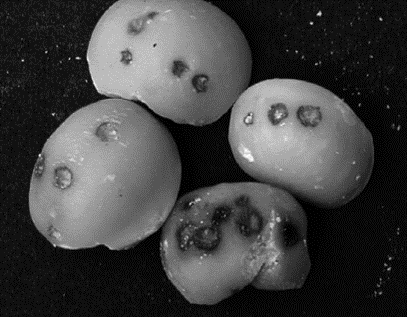
A major drawback in management is the lack of an effective monitoring technique (Jones 2002, Les-key & Hogmire 2005), an issue we address in many studies. Southern green stinkbug cannot survive on macadamia nuts alone and require a primary food plant, or host. Stinkbugs reproduce and develop on the weeds and feed on macadamia when their primary food plants become unavailable.
Growers who continually experience damage should monitor weed hosts surrounding the crop field. It may be possible to utilize trap-borders of preferred hosts such as Crotalaria (rattlepod) to attract and hold stink bug populations. Stink bugs will usually remain on the plants where parasites can readily find them. It is important that these borders not be allowed to dry before control occurs. California used Trissolcus basalis in an effort to control its southern green stink bug population.
Insecticidal applications are usually not required, however sprays may be needed if stink bug populations are high. This pest can be chemically controlled by the use of carbamates & organophosphate compounds. However, because most of these compounds persist on the treated plant for a relatively short period, the crop is vulnerable to re-infestation from nearby areas.
2016 MACADAMIA FIELD DAY
The macadamia is native to Australia and has been grown in California continuously since 1879 (Arpaia 1994). In addition to the commercial growers, macadamias make excellent back yard trees, are beautiful as landscaping, and can be grown in tubs on your patio. There will be a great opportunity for all that are interested to learn about growing macadamia nuts in California.
The University of California Cooperative Extension in conjunction with the California Macadamia Society and the Gold Crown Macadamia Association will hold their Annual Field Day on Saturday 24 September 2016, 8:45 A.M. to 1:30 P.M at the home of Jim and Jane Zeimantz, 3410 Alta Vista Drive, Fallbrook, California. There will be classes on topics relevant to the current macadamia industry, with plenty of opportunities for you to ask questions, both general in nature and about the specifics of your operations. We will also be serving a continental breakfast and a delicious lunch. Please plan to join us for a fun and information filled day.
Cost: $20.00 per person with pre-registration, $25.00 at the event. That includes a continental breakfast and delicious lunch.
Contact Person: Jim Russell, (760) 728-8081 e-mail russellfarms@Roadrunner.com
Visit www.macnuts.org/fieldday.htm for a registration form.
The Objectives of the California Macadamia Society are:
To furnish authoritative and timely information on Macadamia culture.
To assist growers with harvesting and marketing data.
To advise nurserymen on varieties and propagation.
To encourage the University to assist the industry with research.
To formulate policies, where indicated, for presentation to the state legislature.
The Objectives of the California Macadamia Association are:
To assure a reliable market to our growers.
To provide the highest return to our growers for nuts delivered.
To explore new and developing markets for macadamia nuts.
Directions:
From I-5 take exit 54a (east) onto Ca-76, Pala Road. Go 13.5 miles and turn left (north) onto Via Monserate. Go 1.3 miles and turn right on Alta Vista Drive. Go 1 mile to 3410 Alta Vista Drive, on the right.
From I-15 take exit 46 (west) onto Ca-76, Pala Road. Go 3.4 miles and turn right (north) onto Via Monserate. Go 1.3 miles and turn right on Alta Vista Drive. Go 1 mile to 3410 Alta Vista Drive, on the right.
Macadamia Annual Field Day
The macadamia is native to Australia and has been grown in California continuously since 1879 (Arpaia 1994). In addition to the commercial growers, macadamias make excellent back yard trees, are beautiful as landscaping, and can be grown in tubs on your patio. There will be a great opportunity for all that are interested to learn about growing macadamia nuts in California.
The University of California Cooperative Extension in conjunction with the California Macadamia Society and the Gold Crown Macadamia Association will hold their Annual Field Day on Saturday 26 September 2015, 8:45 A.M. to 1:30 P.M. at the home of Jim and Jane Zeimantz, 3410 Alta Vista Drive, Fallbrook, California. There will be classes on topics relevant to the current macadamia industry, with plenty of opportunities for you to ask questions, both general in nature and about the specifics of your operations. We will also be serving a continental breakfast and a delicious lunch. Please plan to join us for a fun and information filled day.
Cost: $20.00 per person with pre-registration, $25.00 at the event. That includes a continental breakfast and delicious lunch.
Contact Person: Jim Russell, (760) 728-8081 e-mail russellfarms@Roadrunner.com
Visit www.macnuts.org/fieldday.htm for a registration form.
The California Macadamia Society has members all over the world.
The Objectives of the California Macadamia Society are:
To furnish authoritative and timely information on Macadamia culture.
To assist growers with harvesting and marketing data.
To advise nurserymen on varieties and propagation.
To encourage the University to assist the industry with research.
To formulate policies, where indicated, for presentation to the state legislature.
The Objectives of the California Macadamia Association are:
To assure a reliable market to our growers.
To provide the highest return to our growers for nuts delivered.
To explore new and developing markets for macadamia nuts.
Directions:
From I-5 take exit 54a (east) onto Ca-76, Pala Road. Go 13.5 miles and turn left (north) onto Via Monserate. Go 1.3 miles and turn right on Alta Vista Drive. Go 1 mile to 3410 Alta Vista Drive, on the right.
From I-15 take exit 46 (west) onto Ca-76, Pala Road. Go 3.4 miles and turn right (north) onto Via Monserate. Go 1.3 miles and turn right on Alta Vista Drive. Go 1 mile to 3410 Alta Vista Drive, on the right.
Work Cited:
Arpaia, M.L. 1994. Macadamia situation for selected countries. California Macadamia Soc. Yearb. 40:27-30.
California Agricultural Production Statistics
California agriculture experienced a nearly three percent increase in the sales value of its products in 2012. The state's 80,500 farms and ranches received a record $44.7 billion for their output last year, up from $43.3 billion in 2011 and $37.9 billion during 2010. California remained the number one state in cash farm receipts with 11.3 percent of the US total. The state accounted for 15 percent of national receipts for crops and 7.1 percent of the US revenue for livestock and livestock products. Exports totaled $18.18 billion in value which represents an eight percent increase over the previous year.
California's agricultural abundance includes more than 400 commodities. The state produces nearly half of US-grown fruits, nuts and vegetables. Across the nation, US consumers regularly purchase several crops produced solely in California.
California's top-ten valued commodities for 2012 are:
- Milk — $6.9 billion
- Grapes — $4.449 billion
- Almonds — $4.347 billion
- Nursery plants — $3.543 billion
- Cattle, Calves — $3.299 billion
- Strawberries — $1.939 billion
- Lettuce — $1.448 billion
- Walnuts — $1.349 billion
- Hay — $1.237 billion
- Tomatoes — $1.170 billion
Please see complete statistics for 2012, reproduced as PDF files below, or use the link in the right column to access this report and others on the NASS website.

workers

